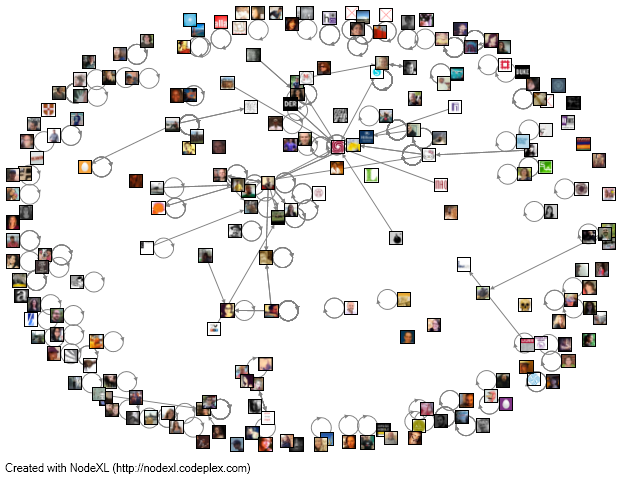It's not exactly a huge data set, but the relatively small number of tweets makes twitter traffic easy to track at the year's AAA in San Francisco. The following graphs were produced with Twitter data using the #AAA2012 hashtag. Utilizing NodeXL, I downloaded data, and constructed a graph using a Fruchterman-Reingold algorithm. I filtered the data by day; the tweets were generated during a 24-hours period ending at the specified time.
In the following, I reproduce the full text of the top five tweets (determined by in-degree) after each visualization..
November 15, 2012: 12:43 pm
1). americananthro
Obama's english and the racial politics of
American English #aaa2012
Still plenty of room at the plenary - come listen
2). savageminds
let's do #tweetup for #aaa2012
Thursday 5-7 at Johnny Foley's.
Leave the Hilton, turn right, cross
the street and you're there.
3). aaa2012
@Melzter777 - not sure what the
rules are but I'm gonna try! *********
4). 01anthropology
Agenda for our business meeting
is up. http://t.co/wnsiMQTI #aaa2012
#dang2012
5). daniellende
Neuroanthropology at Annual AAA
Meeting in San Francisco http://t.co/HXhDYEyr
A booth, a session, a meeting
hope to see you there #aaa2012
November 18, 2012: 3:11 pm
1). johnhawks
End of session approaching, and the
backchannel is heating up. Yay, social
media! #AAA2012
2). americananthro
Go check out Fireball, the party pony
now appearing at @somarts (934 Branan St.)
for the @ethnoterminalia exhibit
at #aaa2012
3). glethnohistory
@chronicle has an article about the
new ED of @americananthro http://
t.co/n4797HU9 #aaa2012
4. clmorgan
Barbara King talking about blogging
fearlessly. Really solid examples from
her work with NPR #AAA2012
5. samueljredman
RT @plazdiquehardt: Just had my
thigh pinched by the hand that
sculpted Lucy for Bone Clones.
He called it a "
November 20, 2012: 12 am
1. RT @clmorgan: @johnhawks I'm
happy that digital sessions got attention
& hope to bring this to the
attention of organizers in the fu . . .
2. rgairnelson
Love my job. "Research is formalized
curiosity. It is poking and prying
with a purpose." Anthropologist
Zora Neale Hurston #aaa2012
3. glethnohistory
#aaa2012 next year there should
be bins to recycle programs in.
That thing is too big for a plane
ride.
4. clmorgan
@johnhawks I'm happy that digital
sessions got attention & hope
to bring this to the attention
of organizers in the future. #AAA2012
5. americananthro
Go check out Fireball, the party
pony now appears at @somarts
(434 Branan St.) for the @ethnoterminalia
exhibit at #aaa2012
November 21, 2012: 2:07 am
1. johnhawks
RT @PeteTaber : Aw, is it over?
Not sure I've had enough Anchor
Steam and Thai food #AAA2012
2. americananthro
Hope you had a great time at #AAA2012!
See you next year at #AAA2013 -
Chicago beckons: http://t.co/3pZxTD2b.
3. rgairnelson
Love my job. "Research is formalized
curiosity. It is poking and prying with a
purpose." Anthropologist Zora Neale Hurston
#aaa2012
4. savageminds
Sssshhh--do you hear that? It's the sound of 5000 700 page long
#AAA2012 conference programs being
thrown away. #sorry trees // Rx #fb.
5. clmorgan
RT @savageminds: Sssshhh--do you hear that?
It's the sound of 5000 700 page long
#AAA2012 conference programs being
thrown away. #sorry
Conclusions
1. For the most part, anthropologists tweet in isolation. At least with respect to the #AAA2012 hashtag, little connects these tweeters with other anthropologists. The density of all of the graphs is low. Moreover, the various controversies that erupt across Twitter during similar events (conferences, concerts, festivals) were notably absent from this conference, and that suggests either a weak investment in social media or the lack of strong ties between anthropologists. In other words, while people may be enmesched in rich, Twitter networks, they are only weakly connected to one another. Are we really bowling alone?
2. Power laws. A hand-full of people dominate the scene in terms of followers and re-tweets; they are invariably people prominent across other social media. Social media re-draws lines of disciplinary power in anthropology, but disciplinary power still concentrates in the hands of the few.
2. The tension between inside and outside. Among SNS platforms, Twitter is unique in that posts frequently represent the liminal zone between online communications and face-to-face interactions. At AAA2012, many posts concerned "location"--9 out of the 20 reproduced above. And yet, only 3 of the posts could be said to engage the city of San Francisco directly (and I'm counting the ethnographic terminalia post twice). Of course, anthropologists go out into the city during the conference, yet, from this analysis (however perfunctory) we might conclude that they rarely do so as part of the conference itself. If one goal for these conferences is to engage place, then Twitter suggests one avenue for conferencing in a less centralized way across different sites in the city. Perhaps one day . . .













